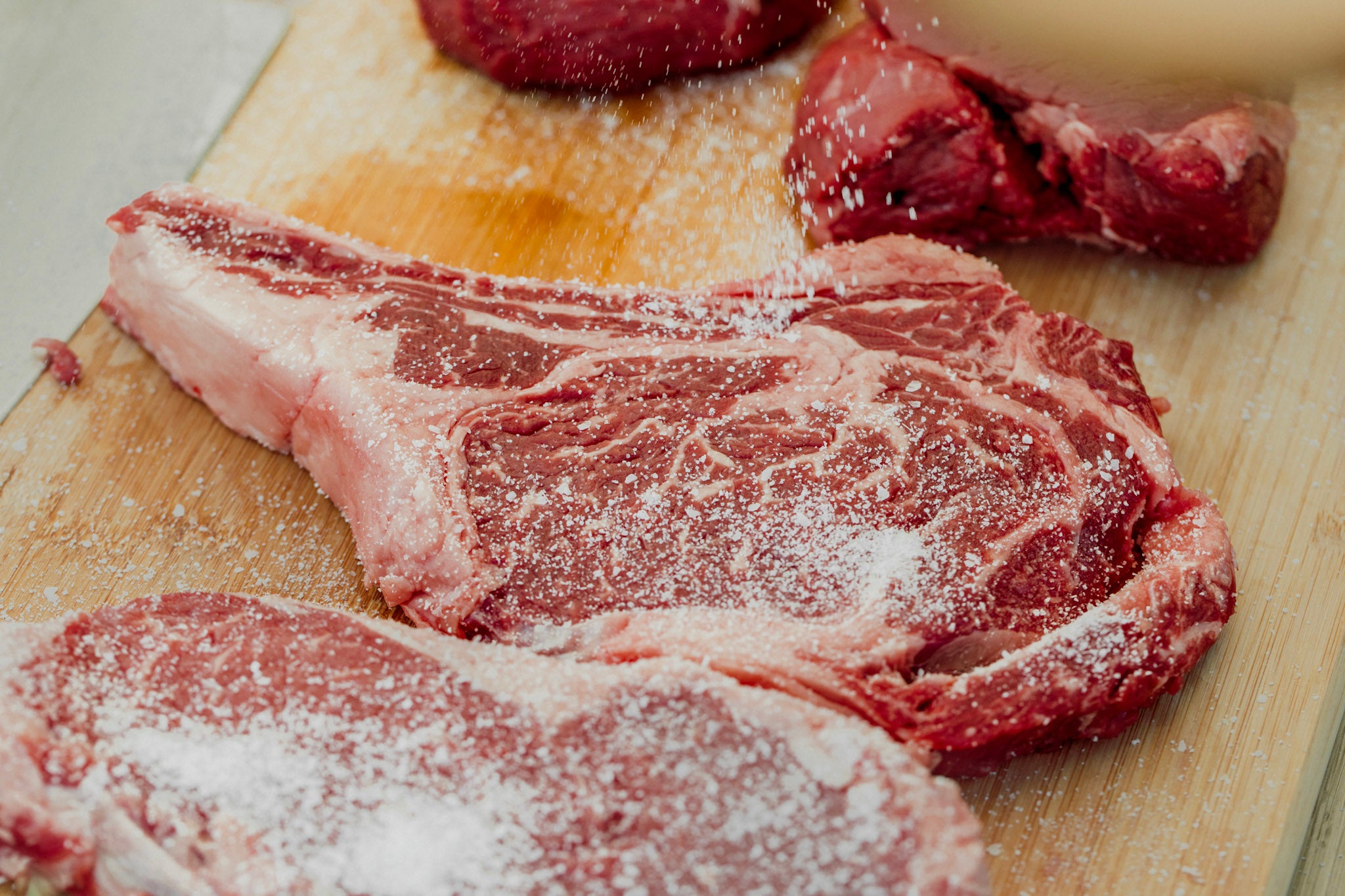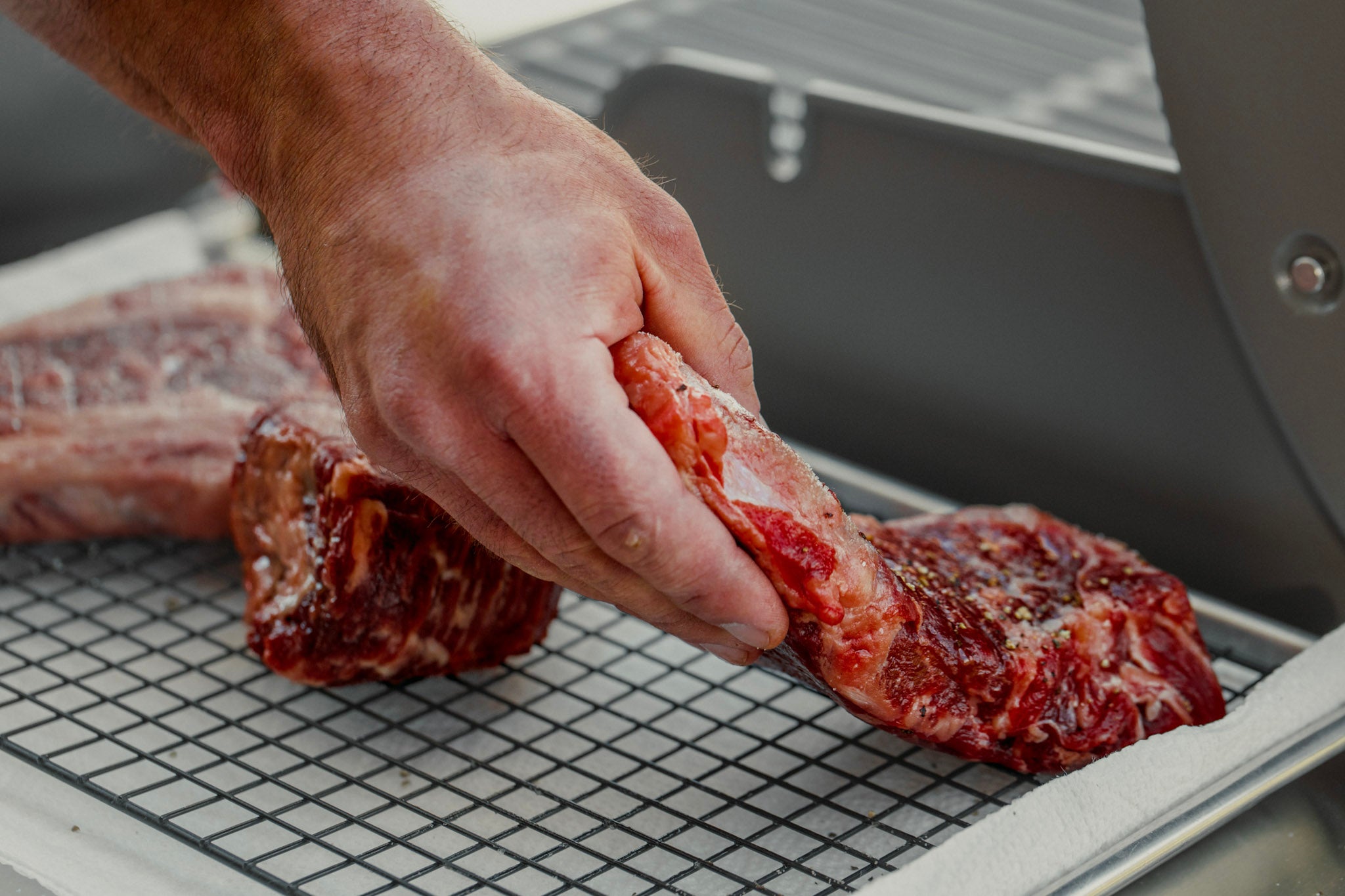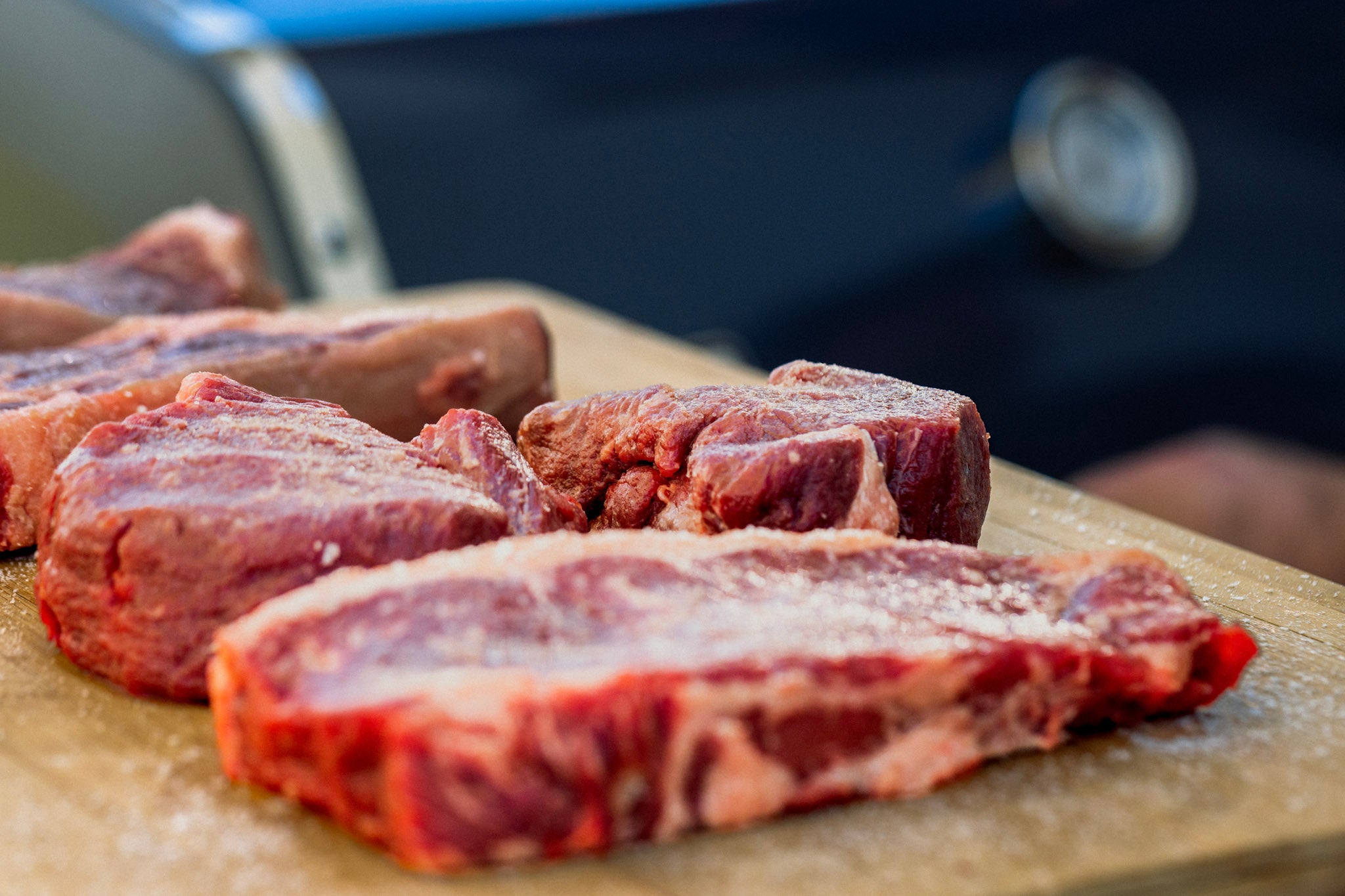
Marbling Magic: Understanding the Role of Fat in Flavorful Beef
Think of the best steak you’ve ever tasted. Most likely, it was juicy and tender, with a rich, buttery flavor. Although preparation and sourcing contribute to quality beef, your unforgettable beef-eating experience can be credited to one thing: fat.
Well, marbling.
Fat marbling gives beef incredible flavor, tenderness, and texture. The fat isn’t your average, chewy, cut-off-and-cast-aside fat. Imagine it as flecks of butter intricately distributed throughout the beef’s muscle. As the beef cooks, the fat melts and self-marinates the meat.
At Lazy T Ranch, we’re passionate about beef marbling and want to help you have more unforgettable dining experiences. Here is everything you need to know about beef marbling and selecting the best cuts:
What is beef marbling, and why is it important in the culinary world?
Have you ever noticed white flecks or streaks in your raw meat? That is intramuscular fat, otherwise known as marbling. The fat earned its moniker due to the swirls it creates in lean muscle, like the pattern of marble and other stones.
Intramuscular fat (marbling) is different from intermuscular fat. Intramuscular is the delicious, in-muscle fat that gives beef its juiciness, tenderness, and flavor. Intermuscular fat is found between muscles and is rubbery and nearly impossible to chew. Since it doesn’t benefit the meat, it’s usually trimmed off.
With beef, intramuscular fat (marbling) is the hero. The more, the better. During the cooking process, the intramuscular fat infuses the beef with a savory richness and velvety texture. It’s no wonder highly marbled beef is coveted by meat connoisseurs.
Not all beef marbling guarantees a fantastic steak.
- Fine marbling consists of thin fat flecks evenly distributed throughout the lean muscle. When cooked, the fat flecks liquefy and make the beef juicy and tender. This type of marbling is the most sought-after, which explains the popularity of Kobe and Wagyu beef.
- Medium marbling offers a less culinary dining experience. Its larger fat flecks aren’t as evenly distributed and take longer to render and liquefy. This often means the beef isn’t as tender and juicy and can have gelatinous fat that isn’t fun to eat. The uneven distribution can also cause parts of the beef to be dryer and tougher than other parts.
- Coarse marbling is considered the worst kind of marbling. It involves large, unevenly distributed flecks or streaks of intramuscular fat.
The bottom line: You need marbling in your beef for flavor and tenderness, but when choosing a cut, it’s important to look for fine marbling—even distribution and thin fat flecks.
How does fat marbling contribute to the flavor profile of beef?
Fat marbling makes beef taste rich, full, and beefy. From a scientific viewpoint, marbling contributes to beef quality in two specific ways. (1) Fatty acids within beef marbling yield carbonyl compounds that are significant flavor contributors. Simply put, fat makes the meat taste good. (2) Fat stores odoriferous compounds, which give the meat an appetizing smell.
With a higher fat content, the beef will have a sweet, buttery taste and less of an acidic aftertaste. It’ll also have more juice than beef with a lower marbling score. The beef marbling fat makes the meat softer and easier to chew since there are fewer muscle fibers. Less chewing means a quicker breakdown of the beef, which in turn yields more flavor.
Although studies have shown that beef’s taste is nonlipid (not sourced from fat, instead natural to the meat), fat is needed to bring out the flavor. Of course, you can enjoy a lean cut of beef, but it won’t have the same robust taste and will need to be cooked properly, usually to rare or medium-rare doneness.
Are there different levels or grades of beef marbling, and if so, what are they?
The USDA (United States Department of Agriculture) grading system includes eight grades of meat: Prime, Choice, Select, Standard, Commercial, Utility, Cutter, and Canner. USDA Prime has the highest marbling content and costs the most on the market. Choice has a decent amount of marbling fat and is available to purchase from most grocery stores. Select, although a lower quality than Choice, is a more affordable option. Standard typically ends up in ground beef products and in cheap steak restaurants.
When grading a beef steer’s marbling, the USDA examines the ribeye muscle between the 12th and 13th ribs. Only steaks with the best marbling (fine and evenly distributed fat flecks) receive USDA Prime certification, the highest rating for beef quality in the United States.
Although the USDA’s grading system includes eight grades, there are international grading systems with larger scales.
The Japanese use a grading system called BMS (Beef Marbling Score) which assigns a number between 1 and 12 to rate a cut of beef’s intramuscular fat. BMS helps compare beef across international grading scales that may differ from USDA guidelines. For example, USDA Prime maxes out at a BMS of 5 while Japanese Wagyu beef can score as high as 12.
In the Australian meat industry, beef marbling is graded on a scale from 0 to 9. This grading system, a component of AUS-MEAT, assesses the marbling within the ribeye muscle.
When shopping for beef, look for the USDA shield (grading). Many sellers and restaurants will label their meat as “Prime” without using the USDA label. They may also refer to their steaks as “premium” or claim their beef was rated in-house. This usually means the seller or restaurant is attempting to cover up lower-quality steaks.
You should also be wary of artificial marbling and steaks labeled as “fat injected” or “fat enhanced.” Artificial marbling occurs when meat sellers inject fat into low-quality cuts. This results in beef that often looks better than naturally marbled steaks. Thankfully, the USDA requires the disclosure of artificial marbling, which makes it easy for you to avoid deception. Be sure to read labels before purchasing beef.
Can you visually identify marbling in raw beef cuts, and are there any specific indicators to look for?
In the United States, Japan, and Australia, trained human graders visually appraise beef to determine its quality. Several factors are considered when grading beef: palatability (tenderness, juiciness, flavor), carcass maturity, firmness, texture, and the color of the lean muscle. Most important of all is the marbling within the lean muscle. Graders assess the amount and size of the white fat flecks in the ribeye muscle (ribbed between the 12th and 13th ribs) and their spatial distribution. Overall, beef grading is determined by the degree of marbling and maturity.
When shopping for beef, look for cuts with thin fat flecks distributed in an even, swirled pattern. At a chilled temperature, the fat should have a firm feel and pure white color.
Does marbling impact the nutritional composition of beef?
The word fat may give you pause. Don’t worry. Beef marbling is unsaturated (healthy) intramuscular fat that’s nutritious in the right amounts. Intramuscular fat is mainly composed of monounsaturated fat that’s rich in vitamins and beneficial fatty acids. It doesn’t increase cholesterol, which is different from unhealthy fats such as trans fat.
Beef is an incredible source of high-quality protein and essential amino acids. Dietary protein is needed for the body’s growth and repair and can also provide energy. On average, an adult man needs an estimated 55g of protein per day while a woman needs 45g.
Eating beef not only meets daily protein requirements but it supplies minerals like zinc, iron, selenium, phosphorous, magnesium, potassium, and copper. Pair these benefits with the nutritional value of intramuscular fat, and you have yourself a superfood.
Are there specific beef cuts or breeds known for exceptional marbling, and if so, which ones?
Angus and Japanese Wagyu are cattle breeds famous for their high marbling content.
Although marbling is mostly determined by genetics, diet and cattle-raising practices contribute to the overall marbling score. The meat industry aims to make beef production more predictable and uniform to increase profits. After all, marbling is about gauging quality.
The following play a role in beef marbling:
- Breed: Certain breeds such as Angus and Wagyu develop better marbling due to how they metabolize food.
- Feed: Marbling can also be affected by what the cattle eat and how long they spend grazing. If the cattle don’t put on enough weight, the marbling leaves their muscles, resulting in lean, often bland, dry meat. Cattle that feed on grain tend to marble easier than strictly grass-fed cattle. (Most feedlot feed contains straw for roughage and grain for protein and carbohydrates.) Not every feed is the same and due to metabolism, not every breed of cattle is the same.
- Muscle use: The general principles of exercise apply to beef marbling. Muscles that aren’t frequently exercised, like the loin, have more fat and thus produce marbled cuts. Active muscles like the leg, shoulder, and rump yield leaner, less marbled cuts.
- Age: Cattle won’t develop the right kind of marbling at a young age. Older cattle won’t produce optimal marbling either.
- Cut: When it comes to marbling and the overall eating experience, the cut of the beef is essential. Even the cattle breeds with the highest marbling content have cuts that are better than others. For example, some cuts might have less marbling but are still tender due to their structure. Other cuts might have a high marbling content but aren’t as tender due to their large muscle fibers.
At Lazy T Ranch, we’re huge fans of our dry-aged Red Angus Ribeye. Even the Choice grade is perfectly marbled and tastes phenomenal when grilled or cooked in a pan.
What are some recommended cooking techniques for maximizing the flavor and tenderness of marbled beef?
- Always remove your beef from the refrigerator 20-30 minutes before cooking. If the meat is too cold, the cooking time, flavor, and tenderness will be negatively affected.
- Either salt your beef immediately before cooking or 40 minutes prior. Salting draws moisture from the meat. If given 40 minutes, the salt will dissolve, and the moisture will reabsorb into the meat, yielding well-seasoned, juicy, tender beef.
- Use a frying pan instead of a grill to keep the marbled fat from melting away. Barbecues and chargrills often get too hot and cause the fat to drip into the flames. This can result in a dry, burnt steak. Instead, cook your marbled beef in a pan over medium heat.
- Rest or not rest. The choice is yours. Learn more about the Resting Debate.
Marbled beef makes for an unforgettable dining experience. See for yourself how quality breeding, cattle raising, and butchery elevate taste and tenderness with Lazy T Ranch's beef. Our meticulous approach to breeding, raising, and butchering ensures that each bite delivers an extraordinary dining experience. The marbling in our beef is a testament to our commitment to excellence and our promise of superior flavor in every cut.
Join us on a culinary journey by bringing our ranch to your table. Taste the richness, feel the melt-in-your-mouth tenderness, and enjoy the premium quality that sets Lazy T Ranch apart. Click here to explore our premium beef boxes today—your taste buds will thank you.


